Financial Accounting Principles: Stakeholders and Reporting Analysis
VerifiedAdded on 2021/02/19
|26
|4897
|64
Report
AI Summary
This report delves into the core principles of financial accounting, examining its role in collecting, analyzing, and presenting financial information through statements like the P&L account and balance sheet. The report focuses on a small accountancy firm, Brooks City Consultancy, and defines financial accounting's significance for internal and external stakeholders. It explores double-entry bookkeeping with ledgers, including a trial balance, and analyzes financial statements like a P&L account for Munteanu Limited. The report also covers key accounting concepts such as consistency and prudence, emphasizing their importance in ensuring the reliability and accuracy of financial reporting. The report then details various types of stakeholders and their specific interests in the financial information provided. The report concludes by outlining the purpose of depreciation in formulating financial statements.
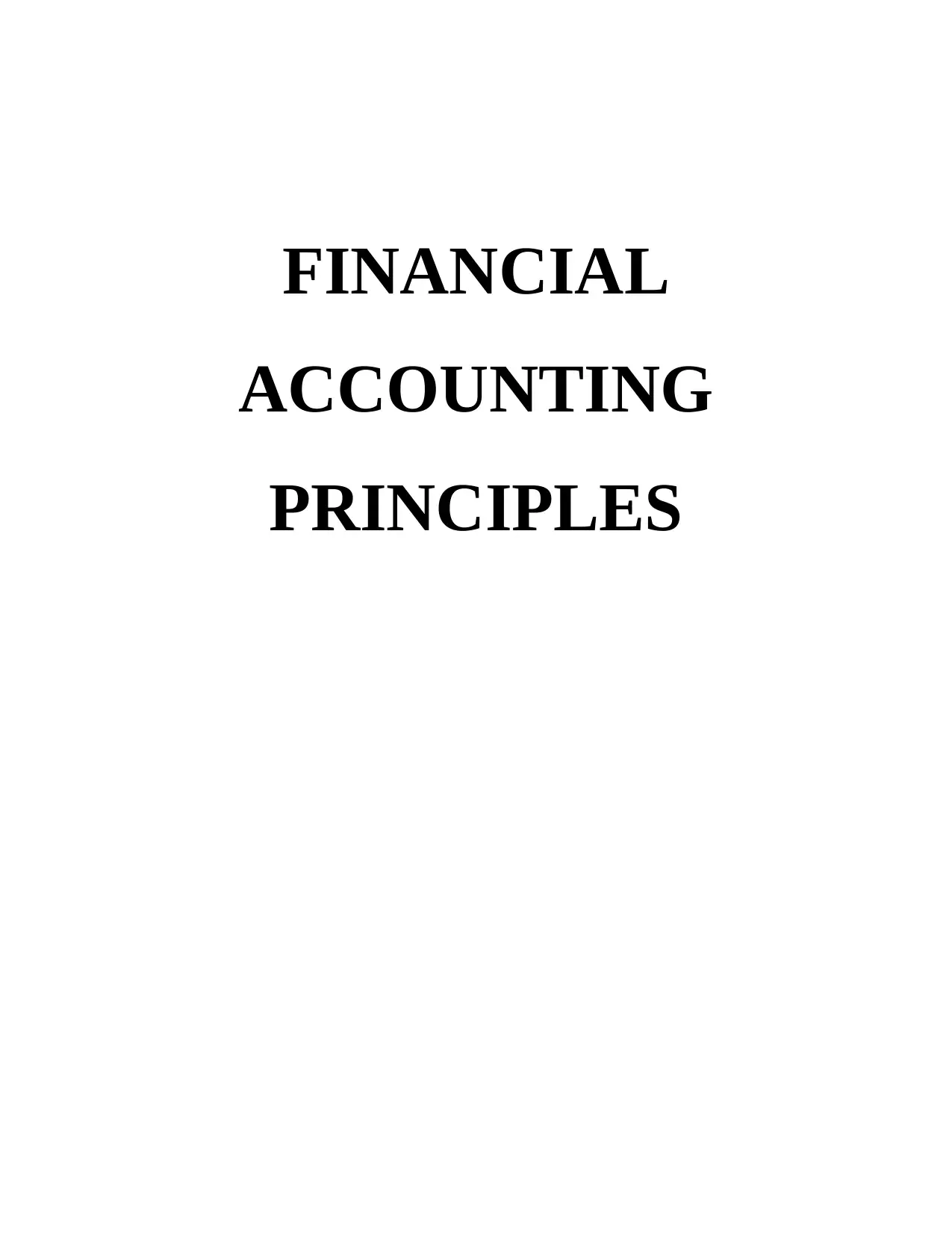
FINANCIAL
ACCOUNTING
PRINCIPLES
ACCOUNTING
PRINCIPLES
Paraphrase This Document
Need a fresh take? Get an instant paraphrase of this document with our AI Paraphraser
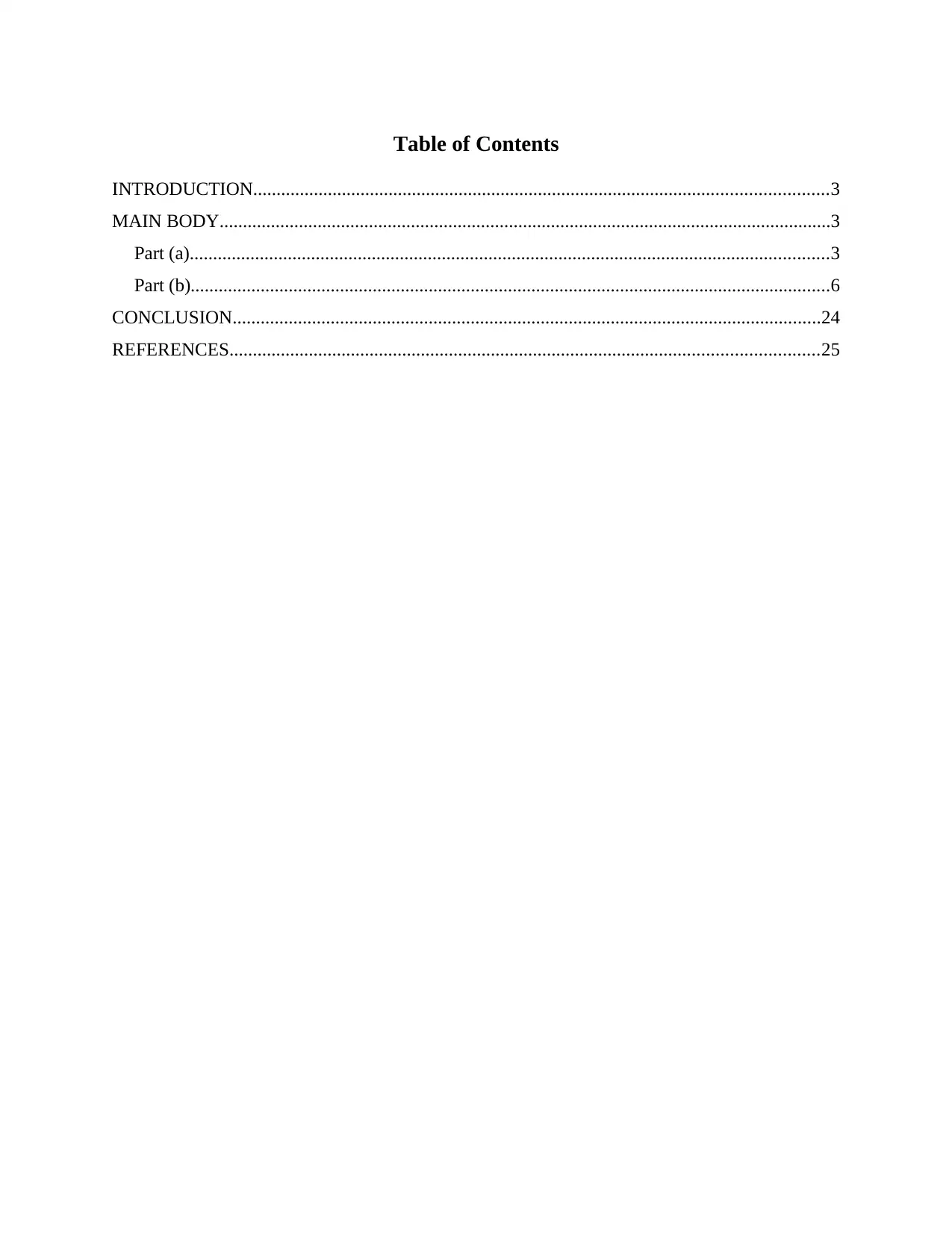
Table of Contents
INTRODUCTION...........................................................................................................................3
MAIN BODY...................................................................................................................................3
Part (a).........................................................................................................................................3
Part (b).........................................................................................................................................6
CONCLUSION..............................................................................................................................24
REFERENCES..............................................................................................................................25
INTRODUCTION...........................................................................................................................3
MAIN BODY...................................................................................................................................3
Part (a).........................................................................................................................................3
Part (b).........................................................................................................................................6
CONCLUSION..............................................................................................................................24
REFERENCES..............................................................................................................................25
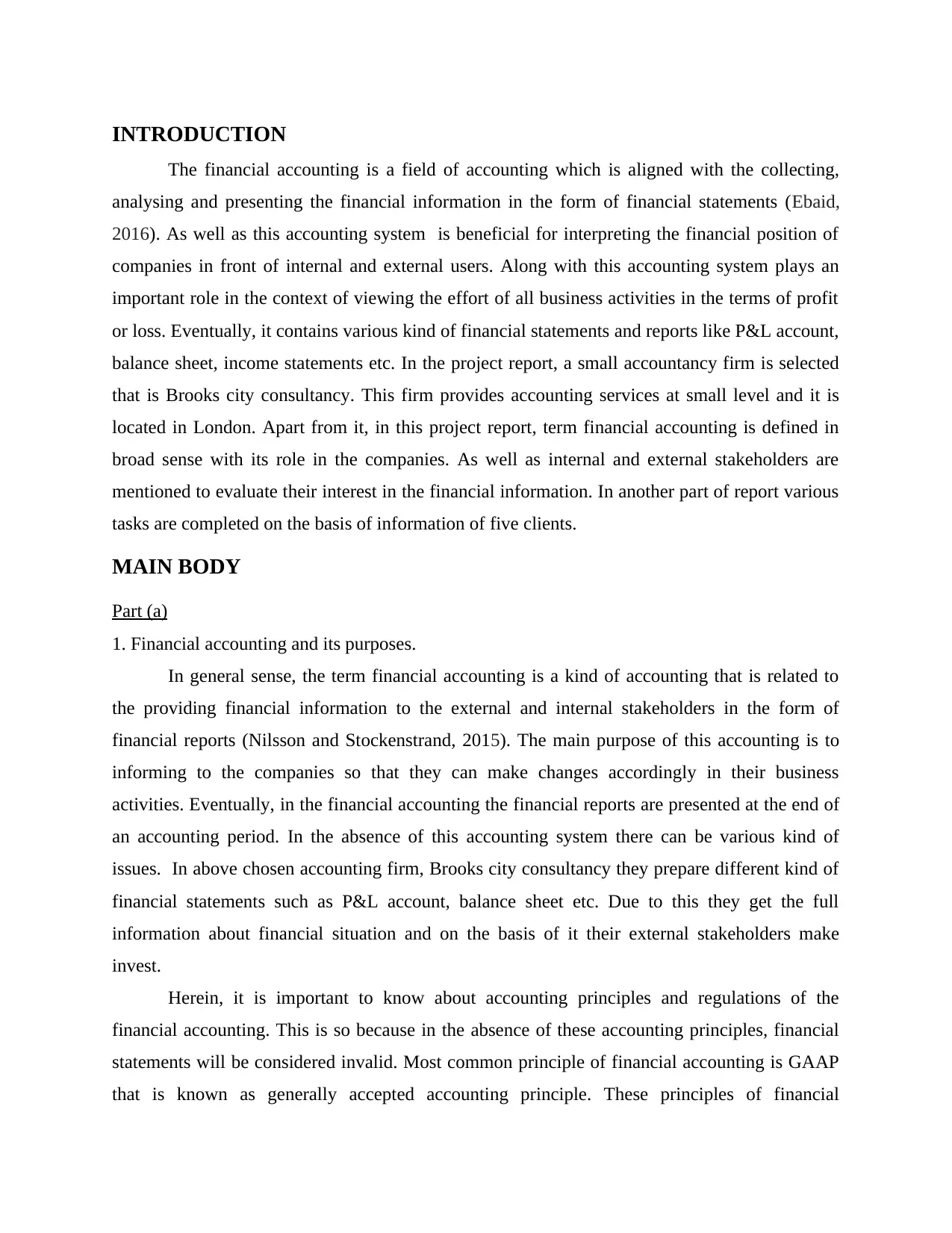
INTRODUCTION
The financial accounting is a field of accounting which is aligned with the collecting,
analysing and presenting the financial information in the form of financial statements (Ebaid,
2016). As well as this accounting system is beneficial for interpreting the financial position of
companies in front of internal and external users. Along with this accounting system plays an
important role in the context of viewing the effort of all business activities in the terms of profit
or loss. Eventually, it contains various kind of financial statements and reports like P&L account,
balance sheet, income statements etc. In the project report, a small accountancy firm is selected
that is Brooks city consultancy. This firm provides accounting services at small level and it is
located in London. Apart from it, in this project report, term financial accounting is defined in
broad sense with its role in the companies. As well as internal and external stakeholders are
mentioned to evaluate their interest in the financial information. In another part of report various
tasks are completed on the basis of information of five clients.
MAIN BODY
Part (a)
1. Financial accounting and its purposes.
In general sense, the term financial accounting is a kind of accounting that is related to
the providing financial information to the external and internal stakeholders in the form of
financial reports (Nilsson and Stockenstrand, 2015). The main purpose of this accounting is to
informing to the companies so that they can make changes accordingly in their business
activities. Eventually, in the financial accounting the financial reports are presented at the end of
an accounting period. In the absence of this accounting system there can be various kind of
issues. In above chosen accounting firm, Brooks city consultancy they prepare different kind of
financial statements such as P&L account, balance sheet etc. Due to this they get the full
information about financial situation and on the basis of it their external stakeholders make
invest.
Herein, it is important to know about accounting principles and regulations of the
financial accounting. This is so because in the absence of these accounting principles, financial
statements will be considered invalid. Most common principle of financial accounting is GAAP
that is known as generally accepted accounting principle. These principles of financial
The financial accounting is a field of accounting which is aligned with the collecting,
analysing and presenting the financial information in the form of financial statements (Ebaid,
2016). As well as this accounting system is beneficial for interpreting the financial position of
companies in front of internal and external users. Along with this accounting system plays an
important role in the context of viewing the effort of all business activities in the terms of profit
or loss. Eventually, it contains various kind of financial statements and reports like P&L account,
balance sheet, income statements etc. In the project report, a small accountancy firm is selected
that is Brooks city consultancy. This firm provides accounting services at small level and it is
located in London. Apart from it, in this project report, term financial accounting is defined in
broad sense with its role in the companies. As well as internal and external stakeholders are
mentioned to evaluate their interest in the financial information. In another part of report various
tasks are completed on the basis of information of five clients.
MAIN BODY
Part (a)
1. Financial accounting and its purposes.
In general sense, the term financial accounting is a kind of accounting that is related to
the providing financial information to the external and internal stakeholders in the form of
financial reports (Nilsson and Stockenstrand, 2015). The main purpose of this accounting is to
informing to the companies so that they can make changes accordingly in their business
activities. Eventually, in the financial accounting the financial reports are presented at the end of
an accounting period. In the absence of this accounting system there can be various kind of
issues. In above chosen accounting firm, Brooks city consultancy they prepare different kind of
financial statements such as P&L account, balance sheet etc. Due to this they get the full
information about financial situation and on the basis of it their external stakeholders make
invest.
Herein, it is important to know about accounting principles and regulations of the
financial accounting. This is so because in the absence of these accounting principles, financial
statements will be considered invalid. Most common principle of financial accounting is GAAP
that is known as generally accepted accounting principle. These principles of financial
⊘ This is a preview!⊘
Do you want full access?
Subscribe today to unlock all pages.

Trusted by 1+ million students worldwide
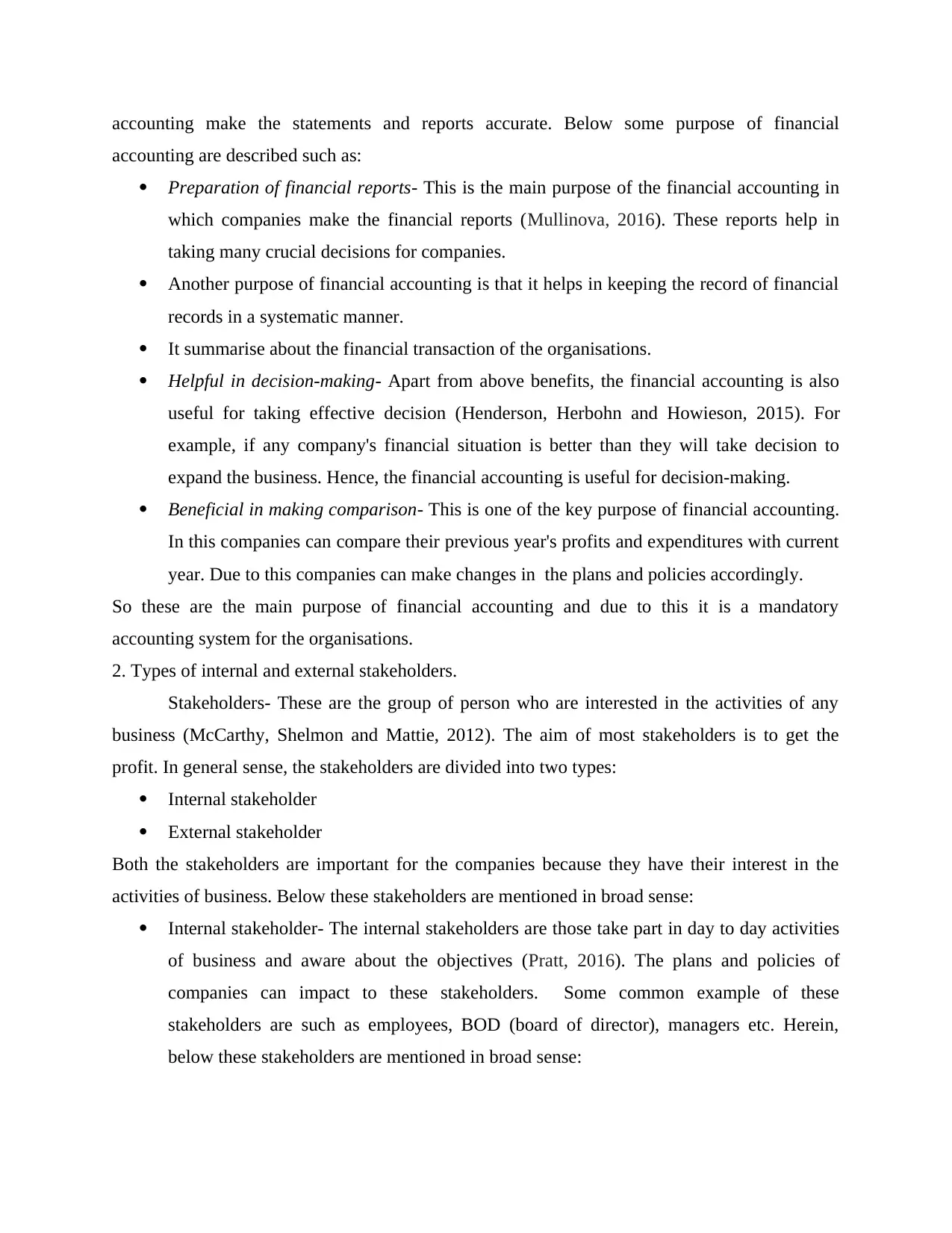
accounting make the statements and reports accurate. Below some purpose of financial
accounting are described such as:
Preparation of financial reports- This is the main purpose of the financial accounting in
which companies make the financial reports (Mullinova, 2016). These reports help in
taking many crucial decisions for companies.
Another purpose of financial accounting is that it helps in keeping the record of financial
records in a systematic manner.
It summarise about the financial transaction of the organisations.
Helpful in decision-making- Apart from above benefits, the financial accounting is also
useful for taking effective decision (Henderson, Herbohn and Howieson, 2015). For
example, if any company's financial situation is better than they will take decision to
expand the business. Hence, the financial accounting is useful for decision-making.
Beneficial in making comparison- This is one of the key purpose of financial accounting.
In this companies can compare their previous year's profits and expenditures with current
year. Due to this companies can make changes in the plans and policies accordingly.
So these are the main purpose of financial accounting and due to this it is a mandatory
accounting system for the organisations.
2. Types of internal and external stakeholders.
Stakeholders- These are the group of person who are interested in the activities of any
business (McCarthy, Shelmon and Mattie, 2012). The aim of most stakeholders is to get the
profit. In general sense, the stakeholders are divided into two types:
Internal stakeholder
External stakeholder
Both the stakeholders are important for the companies because they have their interest in the
activities of business. Below these stakeholders are mentioned in broad sense:
Internal stakeholder- The internal stakeholders are those take part in day to day activities
of business and aware about the objectives (Pratt, 2016). The plans and policies of
companies can impact to these stakeholders. Some common example of these
stakeholders are such as employees, BOD (board of director), managers etc. Herein,
below these stakeholders are mentioned in broad sense:
accounting are described such as:
Preparation of financial reports- This is the main purpose of the financial accounting in
which companies make the financial reports (Mullinova, 2016). These reports help in
taking many crucial decisions for companies.
Another purpose of financial accounting is that it helps in keeping the record of financial
records in a systematic manner.
It summarise about the financial transaction of the organisations.
Helpful in decision-making- Apart from above benefits, the financial accounting is also
useful for taking effective decision (Henderson, Herbohn and Howieson, 2015). For
example, if any company's financial situation is better than they will take decision to
expand the business. Hence, the financial accounting is useful for decision-making.
Beneficial in making comparison- This is one of the key purpose of financial accounting.
In this companies can compare their previous year's profits and expenditures with current
year. Due to this companies can make changes in the plans and policies accordingly.
So these are the main purpose of financial accounting and due to this it is a mandatory
accounting system for the organisations.
2. Types of internal and external stakeholders.
Stakeholders- These are the group of person who are interested in the activities of any
business (McCarthy, Shelmon and Mattie, 2012). The aim of most stakeholders is to get the
profit. In general sense, the stakeholders are divided into two types:
Internal stakeholder
External stakeholder
Both the stakeholders are important for the companies because they have their interest in the
activities of business. Below these stakeholders are mentioned in broad sense:
Internal stakeholder- The internal stakeholders are those take part in day to day activities
of business and aware about the objectives (Pratt, 2016). The plans and policies of
companies can impact to these stakeholders. Some common example of these
stakeholders are such as employees, BOD (board of director), managers etc. Herein,
below these stakeholders are mentioned in broad sense:
Paraphrase This Document
Need a fresh take? Get an instant paraphrase of this document with our AI Paraphraser
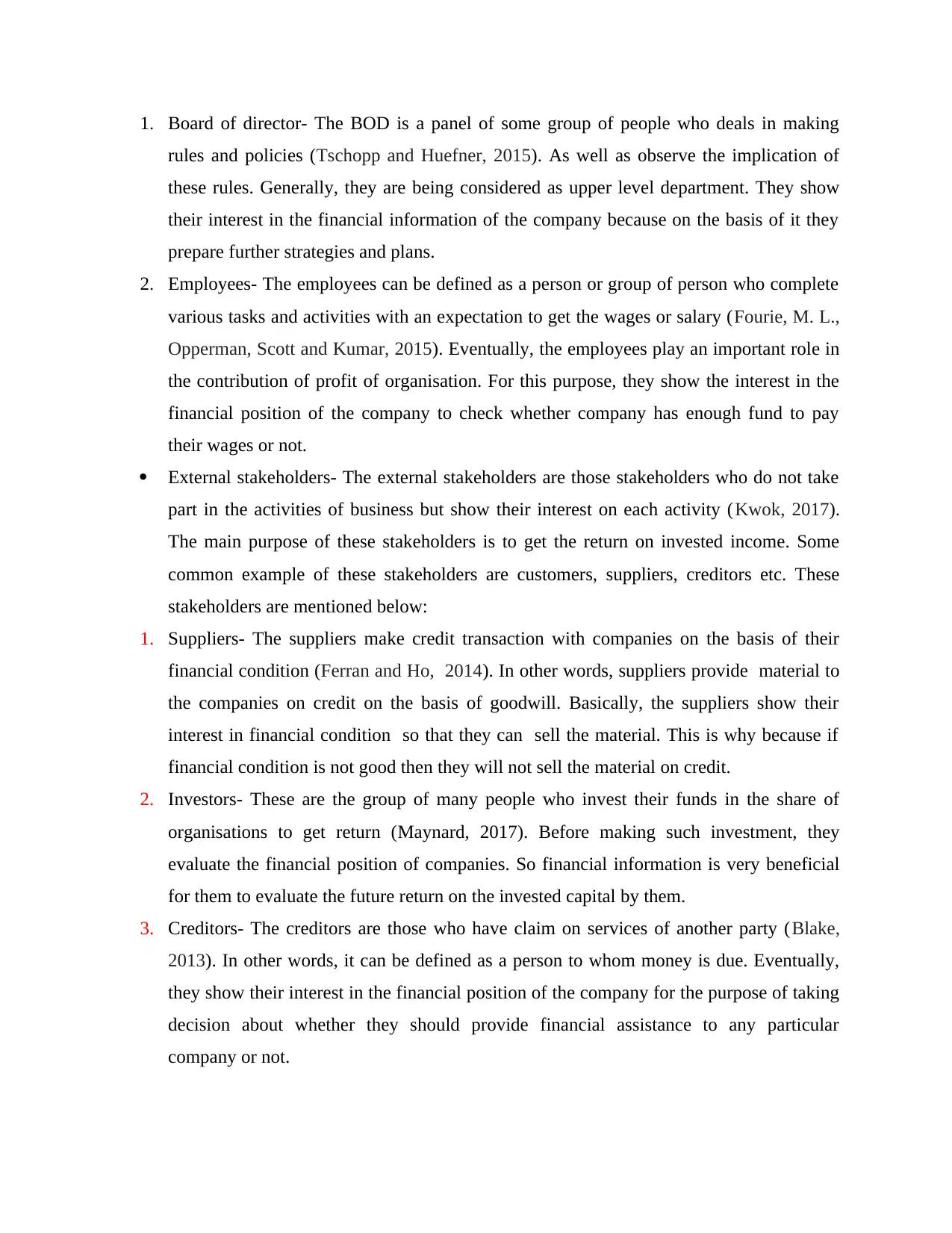
1. Board of director- The BOD is a panel of some group of people who deals in making
rules and policies (Tschopp and Huefner, 2015). As well as observe the implication of
these rules. Generally, they are being considered as upper level department. They show
their interest in the financial information of the company because on the basis of it they
prepare further strategies and plans.
2. Employees- The employees can be defined as a person or group of person who complete
various tasks and activities with an expectation to get the wages or salary (Fourie, M. L.,
Opperman, Scott and Kumar, 2015). Eventually, the employees play an important role in
the contribution of profit of organisation. For this purpose, they show the interest in the
financial position of the company to check whether company has enough fund to pay
their wages or not.
External stakeholders- The external stakeholders are those stakeholders who do not take
part in the activities of business but show their interest on each activity (Kwok, 2017).
The main purpose of these stakeholders is to get the return on invested income. Some
common example of these stakeholders are customers, suppliers, creditors etc. These
stakeholders are mentioned below:
1. Suppliers- The suppliers make credit transaction with companies on the basis of their
financial condition (Ferran and Ho, 2014). In other words, suppliers provide material to
the companies on credit on the basis of goodwill. Basically, the suppliers show their
interest in financial condition so that they can sell the material. This is why because if
financial condition is not good then they will not sell the material on credit.
2. Investors- These are the group of many people who invest their funds in the share of
organisations to get return (Maynard, 2017). Before making such investment, they
evaluate the financial position of companies. So financial information is very beneficial
for them to evaluate the future return on the invested capital by them.
3. Creditors- The creditors are those who have claim on services of another party (Blake,
2013). In other words, it can be defined as a person to whom money is due. Eventually,
they show their interest in the financial position of the company for the purpose of taking
decision about whether they should provide financial assistance to any particular
company or not.
rules and policies (Tschopp and Huefner, 2015). As well as observe the implication of
these rules. Generally, they are being considered as upper level department. They show
their interest in the financial information of the company because on the basis of it they
prepare further strategies and plans.
2. Employees- The employees can be defined as a person or group of person who complete
various tasks and activities with an expectation to get the wages or salary (Fourie, M. L.,
Opperman, Scott and Kumar, 2015). Eventually, the employees play an important role in
the contribution of profit of organisation. For this purpose, they show the interest in the
financial position of the company to check whether company has enough fund to pay
their wages or not.
External stakeholders- The external stakeholders are those stakeholders who do not take
part in the activities of business but show their interest on each activity (Kwok, 2017).
The main purpose of these stakeholders is to get the return on invested income. Some
common example of these stakeholders are customers, suppliers, creditors etc. These
stakeholders are mentioned below:
1. Suppliers- The suppliers make credit transaction with companies on the basis of their
financial condition (Ferran and Ho, 2014). In other words, suppliers provide material to
the companies on credit on the basis of goodwill. Basically, the suppliers show their
interest in financial condition so that they can sell the material. This is why because if
financial condition is not good then they will not sell the material on credit.
2. Investors- These are the group of many people who invest their funds in the share of
organisations to get return (Maynard, 2017). Before making such investment, they
evaluate the financial position of companies. So financial information is very beneficial
for them to evaluate the future return on the invested capital by them.
3. Creditors- The creditors are those who have claim on services of another party (Blake,
2013). In other words, it can be defined as a person to whom money is due. Eventually,
they show their interest in the financial position of the company for the purpose of taking
decision about whether they should provide financial assistance to any particular
company or not.
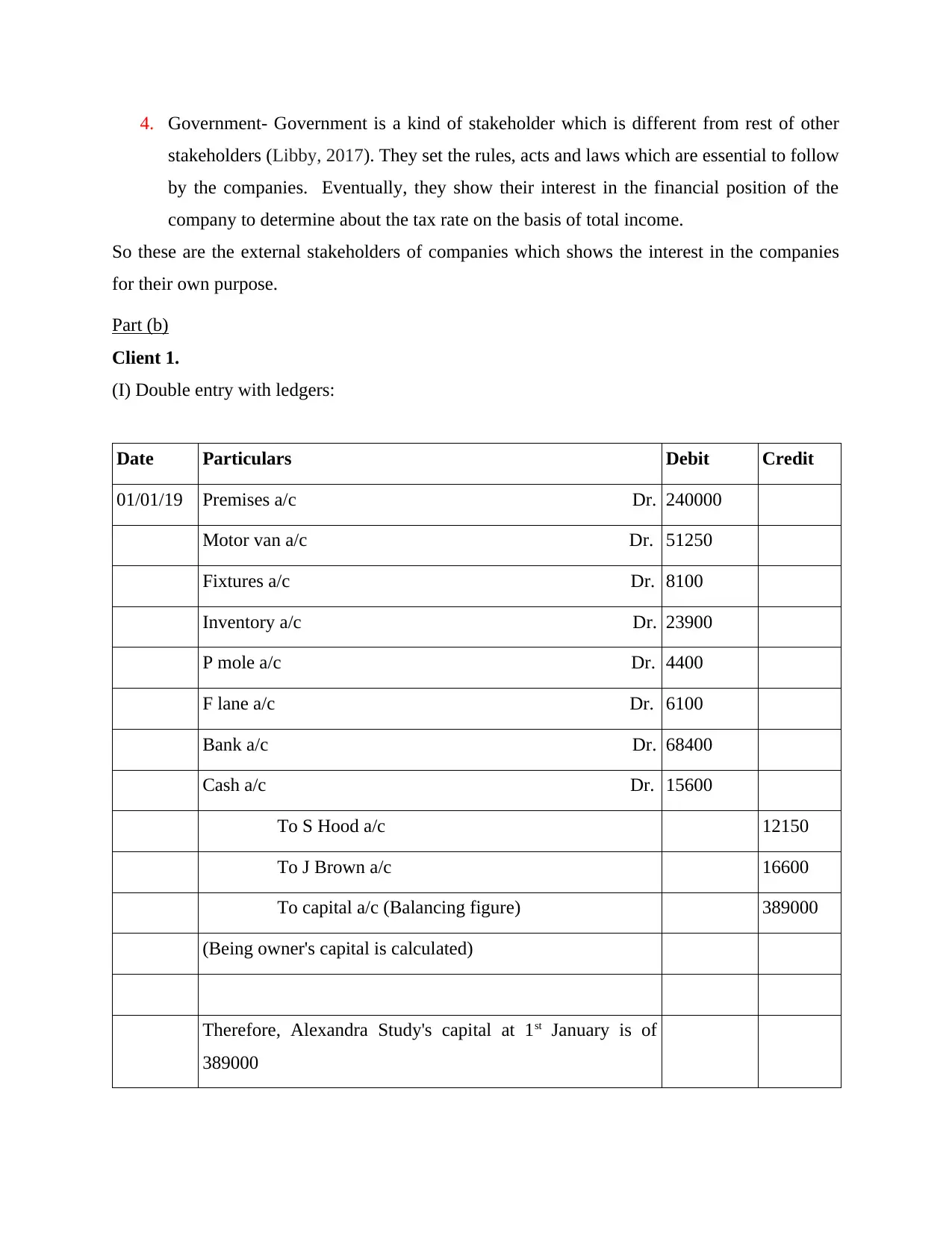
4. Government- Government is a kind of stakeholder which is different from rest of other
stakeholders (Libby, 2017). They set the rules, acts and laws which are essential to follow
by the companies. Eventually, they show their interest in the financial position of the
company to determine about the tax rate on the basis of total income.
So these are the external stakeholders of companies which shows the interest in the companies
for their own purpose.
Part (b)
Client 1.
(I) Double entry with ledgers:
Date Particulars Debit Credit
01/01/19 Premises a/c Dr. 240000
Motor van a/c Dr. 51250
Fixtures a/c Dr. 8100
Inventory a/c Dr. 23900
P mole a/c Dr. 4400
F lane a/c Dr. 6100
Bank a/c Dr. 68400
Cash a/c Dr. 15600
To S Hood a/c 12150
To J Brown a/c 16600
To capital a/c (Balancing figure) 389000
(Being owner's capital is calculated)
Therefore, Alexandra Study's capital at 1st January is of
389000
stakeholders (Libby, 2017). They set the rules, acts and laws which are essential to follow
by the companies. Eventually, they show their interest in the financial position of the
company to determine about the tax rate on the basis of total income.
So these are the external stakeholders of companies which shows the interest in the companies
for their own purpose.
Part (b)
Client 1.
(I) Double entry with ledgers:
Date Particulars Debit Credit
01/01/19 Premises a/c Dr. 240000
Motor van a/c Dr. 51250
Fixtures a/c Dr. 8100
Inventory a/c Dr. 23900
P mole a/c Dr. 4400
F lane a/c Dr. 6100
Bank a/c Dr. 68400
Cash a/c Dr. 15600
To S Hood a/c 12150
To J Brown a/c 16600
To capital a/c (Balancing figure) 389000
(Being owner's capital is calculated)
Therefore, Alexandra Study's capital at 1st January is of
389000
⊘ This is a preview!⊘
Do you want full access?
Subscribe today to unlock all pages.

Trusted by 1+ million students worldwide
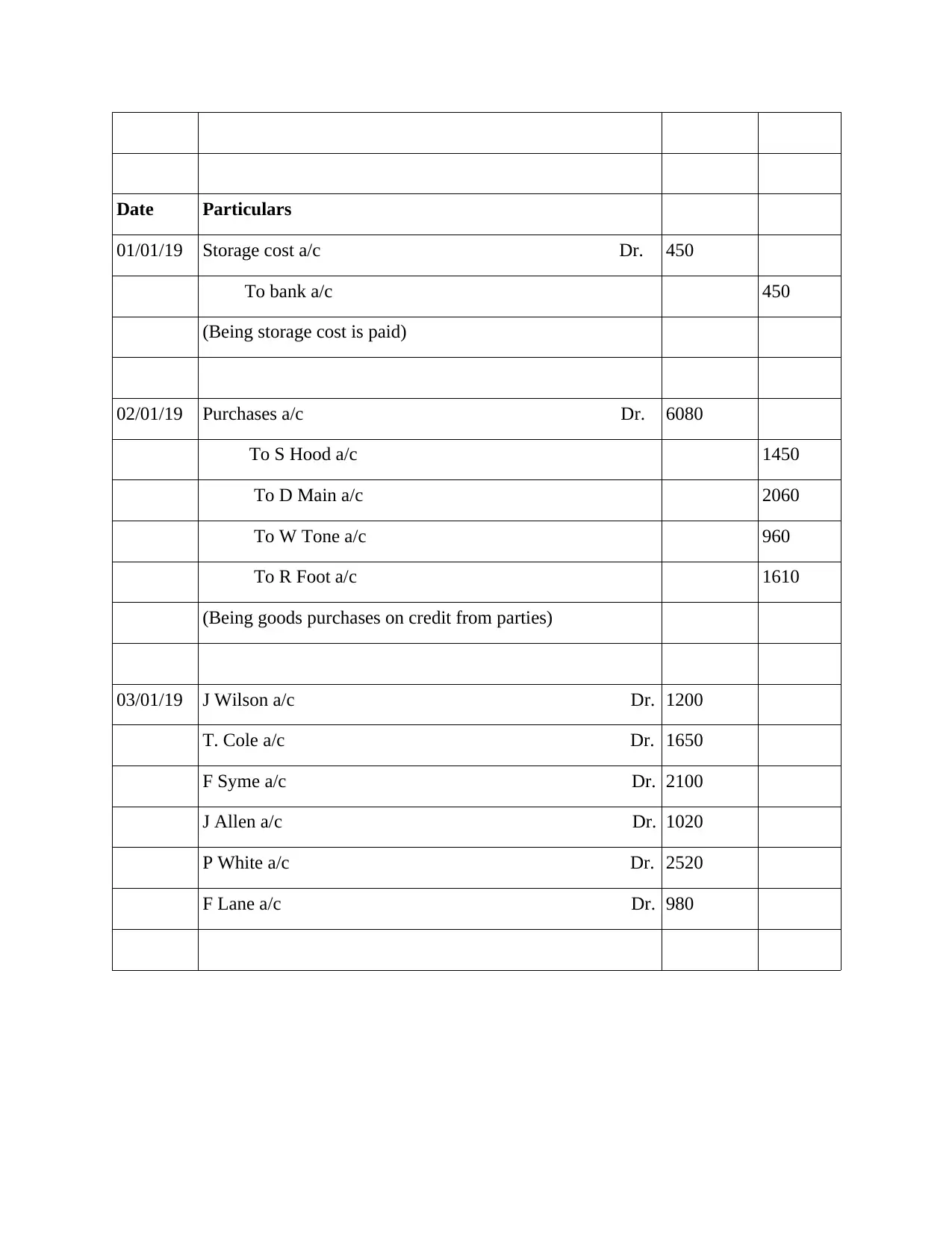
Date Particulars
01/01/19 Storage cost a/c Dr. 450
To bank a/c 450
(Being storage cost is paid)
02/01/19 Purchases a/c Dr. 6080
To S Hood a/c 1450
To D Main a/c 2060
To W Tone a/c 960
To R Foot a/c 1610
(Being goods purchases on credit from parties)
03/01/19 J Wilson a/c Dr. 1200
T. Cole a/c Dr. 1650
F Syme a/c Dr. 2100
J Allen a/c Dr. 1020
P White a/c Dr. 2520
F Lane a/c Dr. 980
01/01/19 Storage cost a/c Dr. 450
To bank a/c 450
(Being storage cost is paid)
02/01/19 Purchases a/c Dr. 6080
To S Hood a/c 1450
To D Main a/c 2060
To W Tone a/c 960
To R Foot a/c 1610
(Being goods purchases on credit from parties)
03/01/19 J Wilson a/c Dr. 1200
T. Cole a/c Dr. 1650
F Syme a/c Dr. 2100
J Allen a/c Dr. 1020
P White a/c Dr. 2520
F Lane a/c Dr. 980
Paraphrase This Document
Need a fresh take? Get an instant paraphrase of this document with our AI Paraphraser
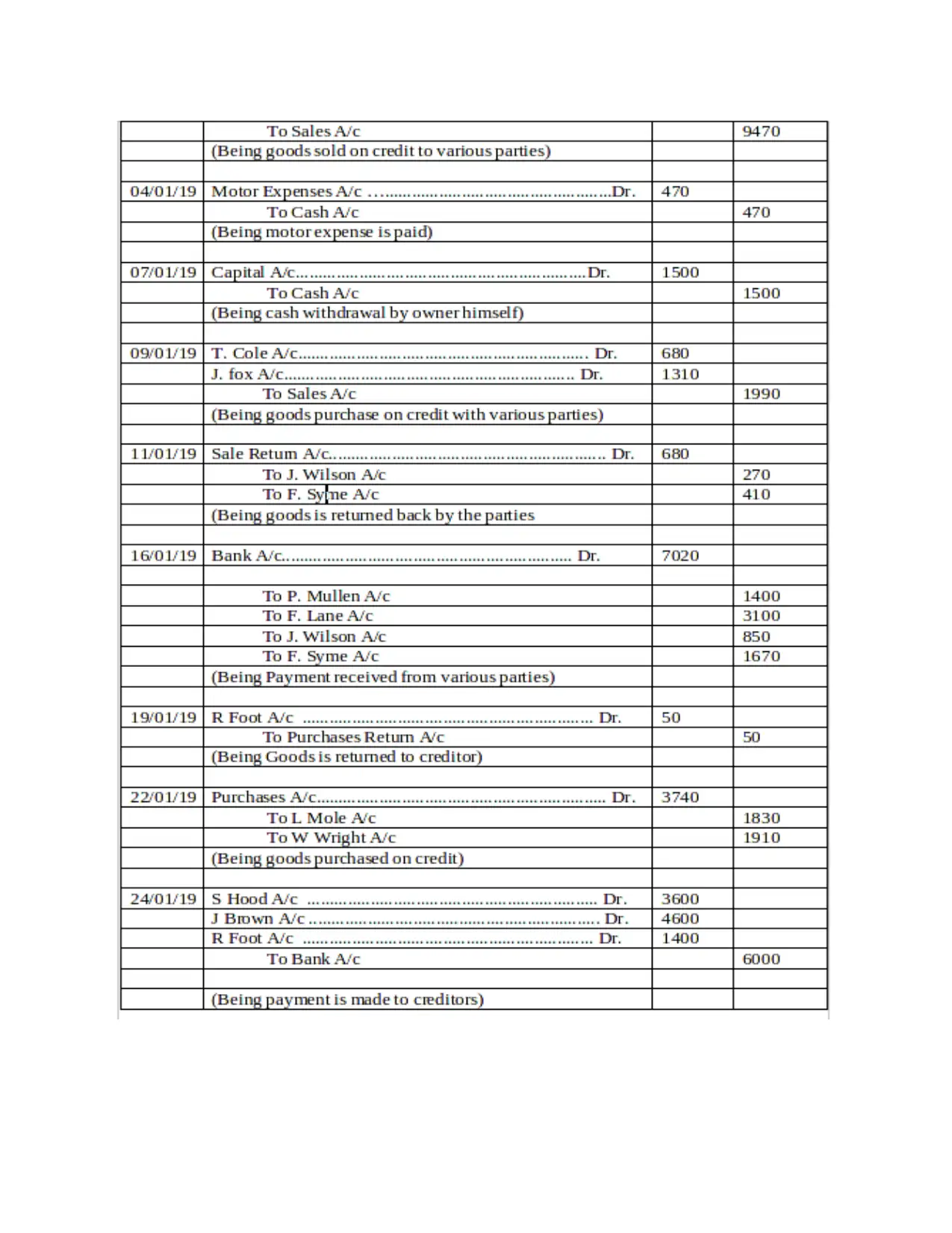
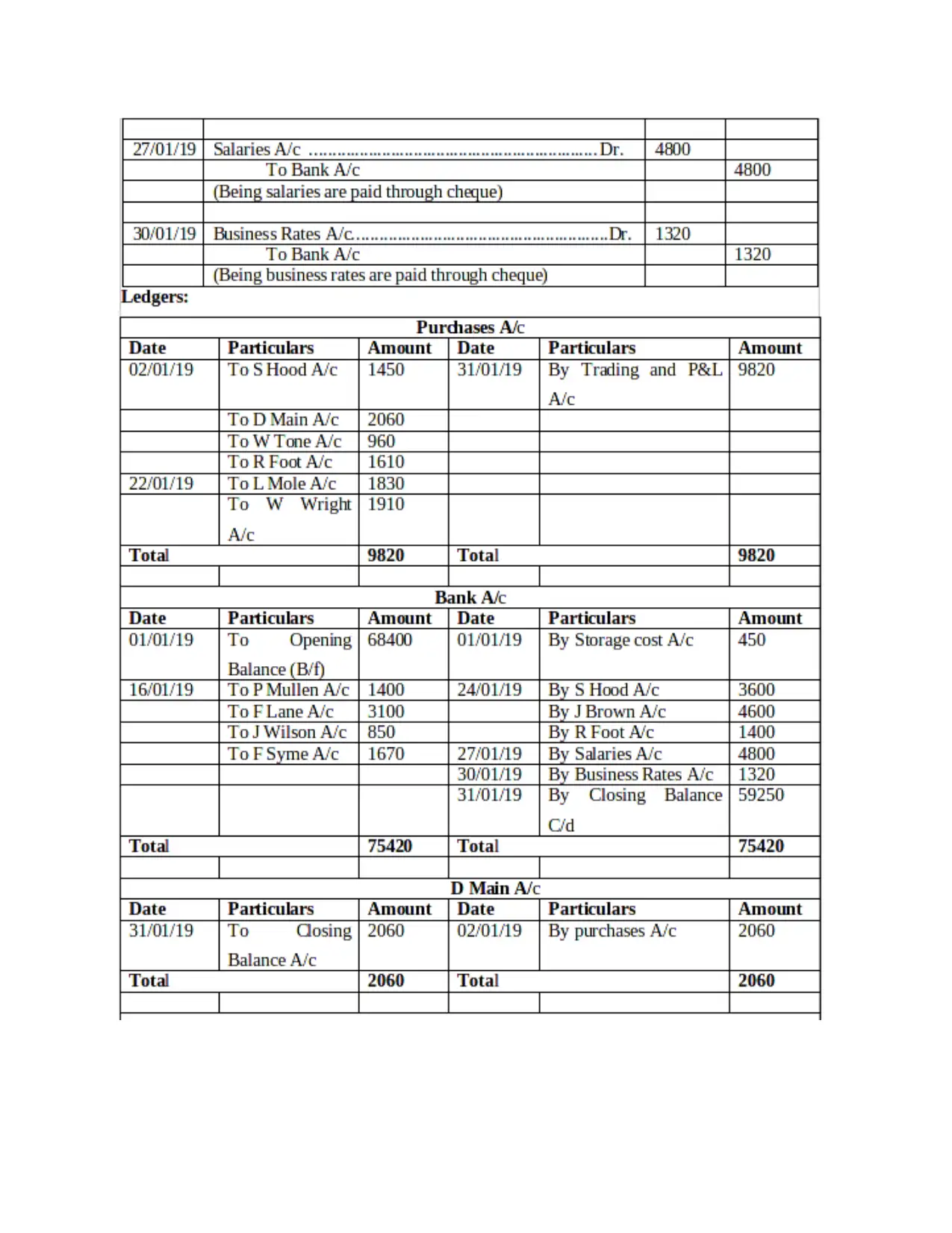
⊘ This is a preview!⊘
Do you want full access?
Subscribe today to unlock all pages.

Trusted by 1+ million students worldwide
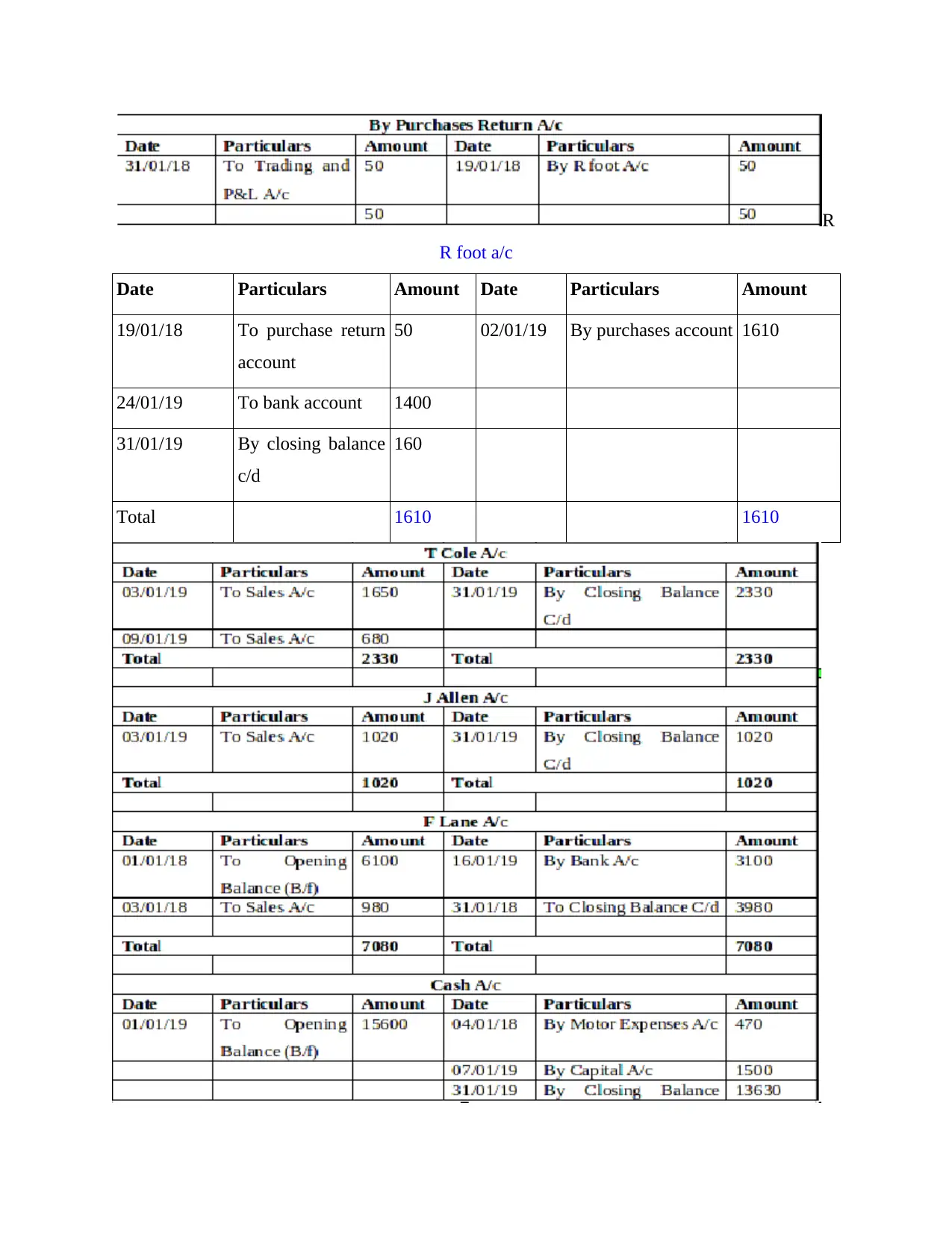
R
R foot a/c
Date Particulars Amount Date Particulars Amount
19/01/18 To purchase return
account
50 02/01/19 By purchases account 1610
24/01/19 To bank account 1400
31/01/19 By closing balance
c/d
160
Total 1610 1610
R foot a/c
Date Particulars Amount Date Particulars Amount
19/01/18 To purchase return
account
50 02/01/19 By purchases account 1610
24/01/19 To bank account 1400
31/01/19 By closing balance
c/d
160
Total 1610 1610
Paraphrase This Document
Need a fresh take? Get an instant paraphrase of this document with our AI Paraphraser
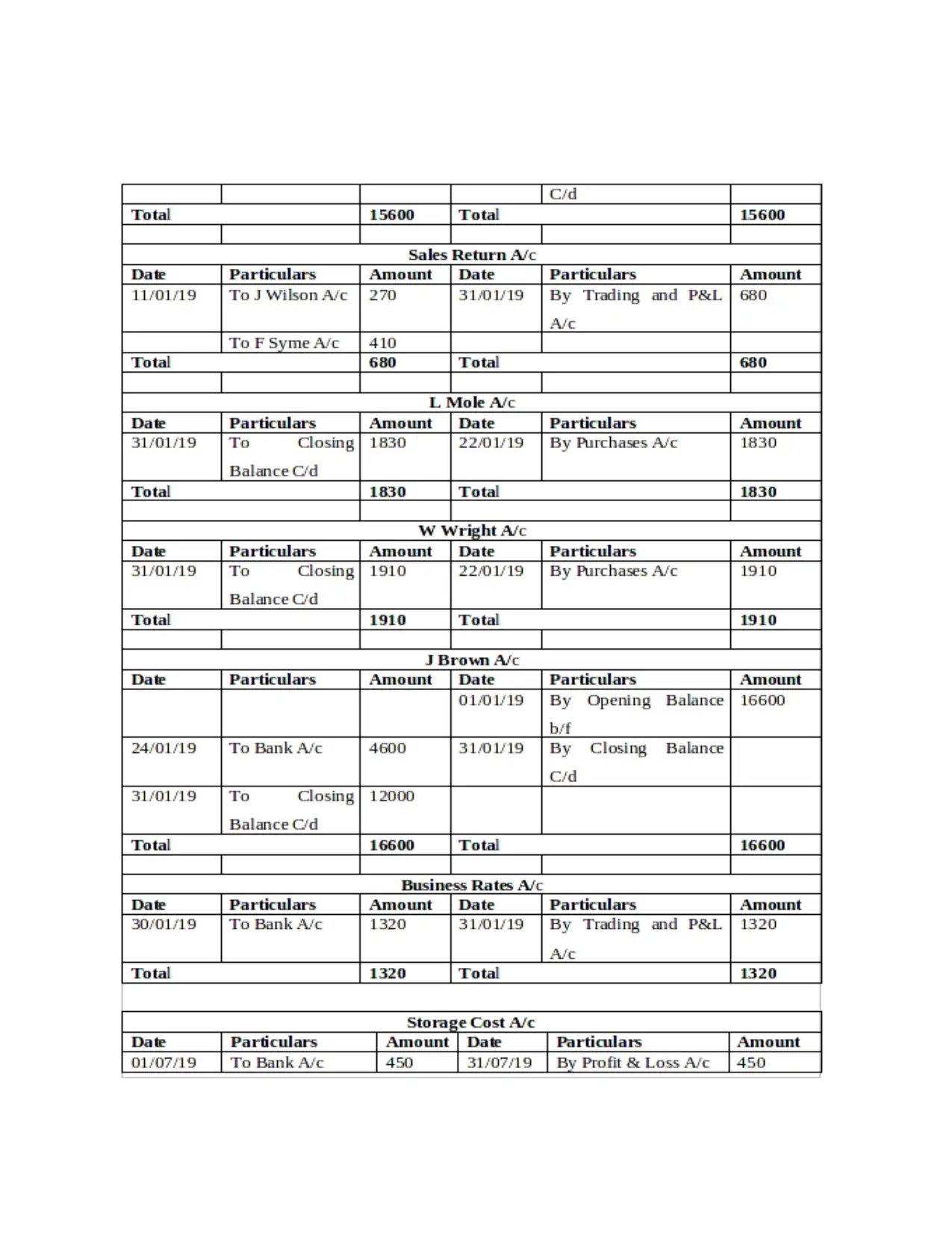
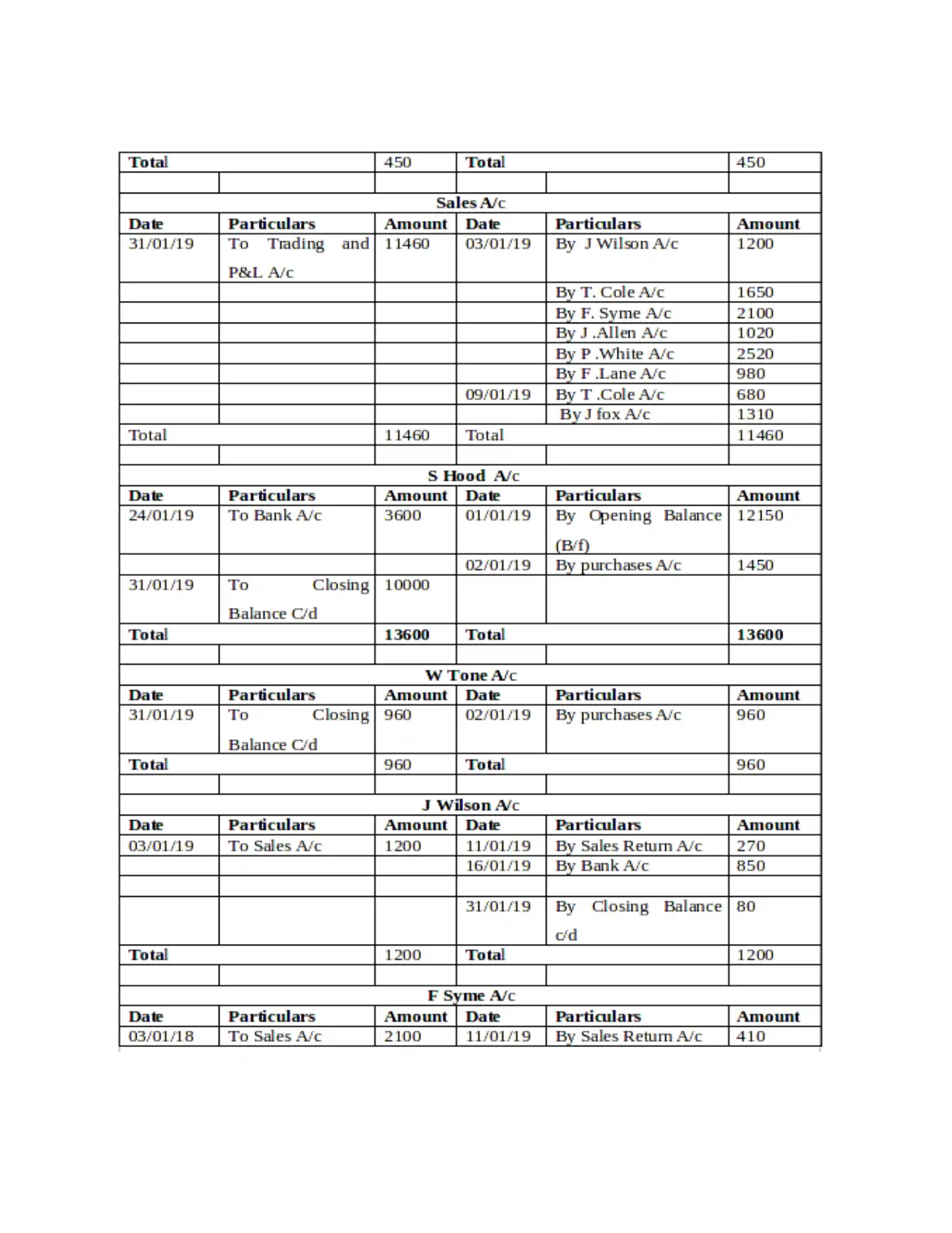
⊘ This is a preview!⊘
Do you want full access?
Subscribe today to unlock all pages.

Trusted by 1+ million students worldwide
1 out of 26
Related Documents
Your All-in-One AI-Powered Toolkit for Academic Success.
+13062052269
info@desklib.com
Available 24*7 on WhatsApp / Email
![[object Object]](/_next/static/media/star-bottom.7253800d.svg)
Unlock your academic potential
Copyright © 2020–2025 A2Z Services. All Rights Reserved. Developed and managed by ZUCOL.





